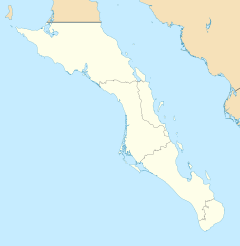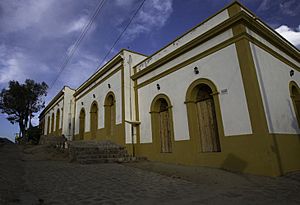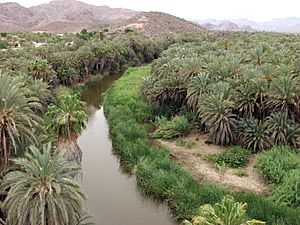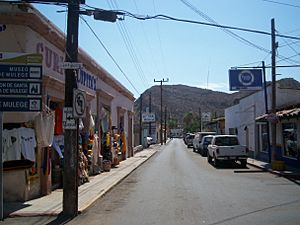Mulegé facts for kids
Quick facts for kids
Mulegé
|
|
|---|---|
| Heroica Mulegé | |
|
Top: Mulegé oasis; middle: Mission Santa Rosalía de Mulegé (left) and downtown (right); bottom: Bahía Concepción (left) and Misión Santa Rosalía de Mulegé, lateral facade (right).
|
|
| Country | |
| State | Baja California Sur |
| Municipality | Mulegé |
| Elevation | 52 ft (16 m) |
| Population
(2020)
|
|
| • Total | 3,834 |
| Time zone | UTC-7 (Pacific (US Mountain)) |
| • Summer (DST) | UTC-6 (Pacific) |
Mulegé is a small city in Baja California Sur, a state in Mexico. It's located right by the beautiful Gulf of California. In 2020, about 3,834 people lived there.
History of Mulegé
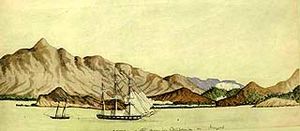
People have lived in the Mulegé area for thousands of years. They chose this spot because the river valley had plenty of water. You can still see amazing ancient cave paintings in the nearby Sierra de Guadalupe mountains.
In 1702, a Jesuit priest named Juan Maria de Salvatierra thought Mulegé would be a good place for a mission. Later, in 1754, Father Francisco Escalante began building the Misión Santa Rosalía de Mulegé. Many other Jesuit priests came to the area to share the Catholic faith.
The official name of the town is "Heroica Mulegé." This special title comes from events during the Mexican-American War (1846–1848). During this war, American forces tried to take over parts of Mexico's Pacific coast. This included areas like California, Baja California, and New Mexico.
However, the brave people of Mulegé and nearby towns fought back. They successfully stopped the Americans from occupying their area. Because of their victory, Mulegé was given the official title "Heroica Mulegé" by the Mexican government. "Heroica" means "heroic" in Spanish.
The old prison in Mulegé is famous for a unique reason: it didn't have bars! Prisoners could walk around town freely. They could even live with their families. They just had to return to the prison building in the evening. Escapes were very rare. This was because Mulegé was very remote. It was surrounded by harsh desert for many miles. Also, all prisoners had to agree to help catch anyone who tried to escape. Today, the old prison is a museum you can visit.
Geography of Mulegé
The entire Baja California peninsula gets very little rain. It's one of the driest places in the world. When it does rain, usually between December and March, it can be very heavy. Hurricanes are also a big threat to the Mulegé area. People in Baja California often say, "It never rains in Baja, but if it rains, it pours."
Even though it's a dry region, the Mulegé river valley has fertile soil and a good water supply. This has allowed farming to be a strong part of the local economy. Farmers here grow tropical fruits like oranges, bananas, limes, and mangoes.
Economy and Tourism
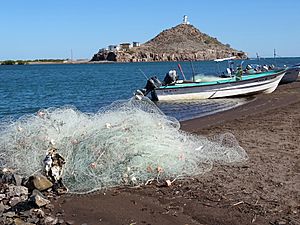
Mulegé is known around the world for its amazing fishing in the Gulf of California. A warm ocean current from the south and a cold current from the north meet near Mulegé. This mix brings together many different kinds of fish. The Gulf is sometimes called the "Sea of Cortez." This name comes from the Spanish explorer, Hernán Cortés, who sailed into this area long ago.
In the past, Mulegé's economy mainly depended on fishing and farming. Today, tourism is a very important source of income for the city. Many visitors come for the deep-sea fishing. Other popular activities include kayaking, exploring caves, bird watching, and regular fishing. You can even hire a boat to try and catch a huge game fish!
Tourism really grew in Mulegé after Highway MX 1 was built in 1976. This paved road made it much easier to reach Mulegé by land. Before the highway, a trip from the U.S. border could take four days. Now, it takes about 12 hours.
The area has faced challenges from hurricanes. Major storms like Hurricane John (2006), Tropical Storm Julio (2008), Hurricane Jimena (2009), Hurricane Paul (2012), and Hurricane Odile (2014) have caused damage. These hurricanes brought heavy rain and big floods. In Mulegé, the floods were severe. The highway bridge was under more than 20 feet of water. Some parts of town had 6 feet of water. Many homes in the river valley were washed away into the Gulf of California. Cleanup efforts continued for a long time after these storms.
Transportation
You can reach Mulegé by land using Mexican Federal Highway 1. This highway runs all the way from Tijuana at the U.S.-Mexico border down to Cabo San Lucas.
For air travel, Mulegé has three small airstrips for private planes: El Gallito Airstrip, Mulegé Airstrip, and Punta San Pedro Airstrip. If you need a regional flight, you can use the Palo Verde Airport north of town. For international flights, the Loreto Airport is about 123 kilometers (76 miles) to the south.
See also
 In Spanish: Mulegé para niños
In Spanish: Mulegé para niños







